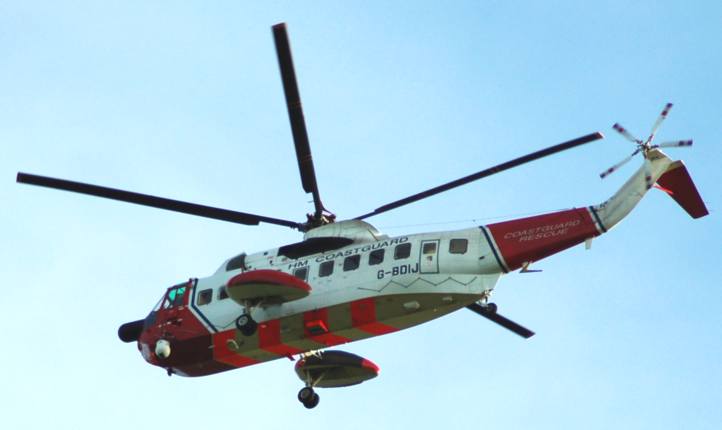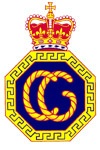|
Her
Majesty's Coastguard is the service of the government of the United Kingdom concerned with co-ordinating rescue at sea.
HM Coastguard is a section of the Maritime and Coastguard Agency responsible for the initiation and co-ordination of all civilian maritime SAR within the UK Maritime Search and Rescue Region. This includes the mobilisation, organisation and tasking of adequate resources to respond to persons either in distress at sea, or to persons at risk of injury or death on the cliffs or shoreline of the United Kingdom.

HM Coastguard helicopter "India Juliet" over Dorset
History
In 1809 the Preventative Water Guard was established and can be regarded as the immediate ancestor of HM Coastguard. Its primary objective was to prevent smuggling, but it was also responsible for giving assistance to shipwrecks.
Each Water Guard station was issued with Manby's Mortar which was invented by Captain George William Manby. The mortar fired a shot with a line attached from the shore to the wrecked ship and was used for many years.
In 1821 a committee of enquiry recommended that responsibility for the Preventative Water Guard be transferred to the Board of Customs. The
Treasury agreed and in a Minute dated 15 January 1822, directed that the preventative services, which consisted of the Preventative Water Guard, cruisers, and Riding Officers should be placed under the authority of the Board of Customs and in future should be named the Coast Guard.
In 1829 the first Coast Guard instructions were published and dealt with discipline and directions for carrying out preventative duties. They also stipulated that when a wreck took place, the Coast Guard was responsible for taking all possible action to save lives, to take charge of the vessel and to protect property.
Efficiency drives in the 1990s made Her Majesty's Coastguard a government executive agency, then in 1998 the Marine Safety Agency and the Coastguard Agency were joined to become the Maritime and Coastguard Agency (MCA).
The Coastguard has a museum at Sewerby Hall near Bridlington to commemorate the 200 year history of the agency. HRH The Prince of Wales is an honorary Commodore of HM Coastguard.
Role
The Maritime and Coastguard Agency (MCA) is an executive agency responsible throughout the UK for implementing the Government’s maritime safety policy. That includes co-ordinating search and rescue at sea through Her Majesty’s Coastguard, checking that ships meet
UK and international safety rules and preventing coastal pollution.
Typical emergencies to which the Coastguard is summoned include:
-
Sailboarders too exhausted to reach the shore
-
Walkers and animals that slip from the scenic cliff path
-
Boats losing rudder control
-
Crew stranded aboard a container ship battered by freak waves
-
Medical emergencies
-
Incidents involving
oil rigs (such as fire)
-
Suicide victims that have flung themselves from cliffs or bridges
Ships in distress or the public reporting an accident should make a Mayday call on MF radio, marine VHF radio channel 16, or by dialling 999 or 112 on a telephone. The Coastguard continuously monitors all the maritime distress frequencies (including the international VHF distress frequency 156.8 MHz) and has access to Satellite based monitoring systems. The Coastguard then co-ordinates the emergency response. This normally involves requesting the launch of a local RNLI lifeboat, deploying a local Coastguard unit, or a search and rescue helicopter. Depending on the circumstances of each incident, the Coastguard may also arrange for other emergency services to be deployed to the incident or to meet other units returing from the incident, for example in the case of a medical emergency. A full list of 'Declared Assets' is below:
HM Coastguard's own CRO Initial Response and Coastguard Rescue Teams;
Inshore lifeboats, all-weather lifeboats and inshore rescue hovercraft operated by the Royal; National Lifeboat Institution;
other nominated inshore rescue services;
Search and Rescue helicopters under contract to the MCA;
Ministry of Defence SAR helicopters and fixed wing aircraft operated by the Royal Air Force (RAF) and Royal Navy (RN);
Emergency Towing Vessels (ETV) - powerful tugs contracted to the MCA;
nominated Fire Service teams for cliff and mud rescue as well as firefighting and chemical incident response for vessels at sea;
nominated beach lifeguard units.
The Coastguard has seven rescue helicopters based around the United Kingdom (at Stornoway Airport, Sumburgh
Airport, Lee-on-Solent, Portland). The Coastguard also has use of other Air-Sea Rescue helicopters provided by the Royal Navy, Royal Air Force,
United States Air Force and the Irish Air Corps.
Isle of Man
Since 1989, the Isle of Man has had its own Coastguard service. It was created in response to the closure of the HM Coastguard station at Ramsey. HM Coastguard in Liverpool retained responsibility for all sea-rescues off the Manx coast until 1991, when the Isle of Man
Government purchased territorial waters from the United Kingdom.

LINKS
and REFERENCE

New
energy drinks for performers
..
Thirst for Life

330ml
Earth can - the World in Your Hands
|


